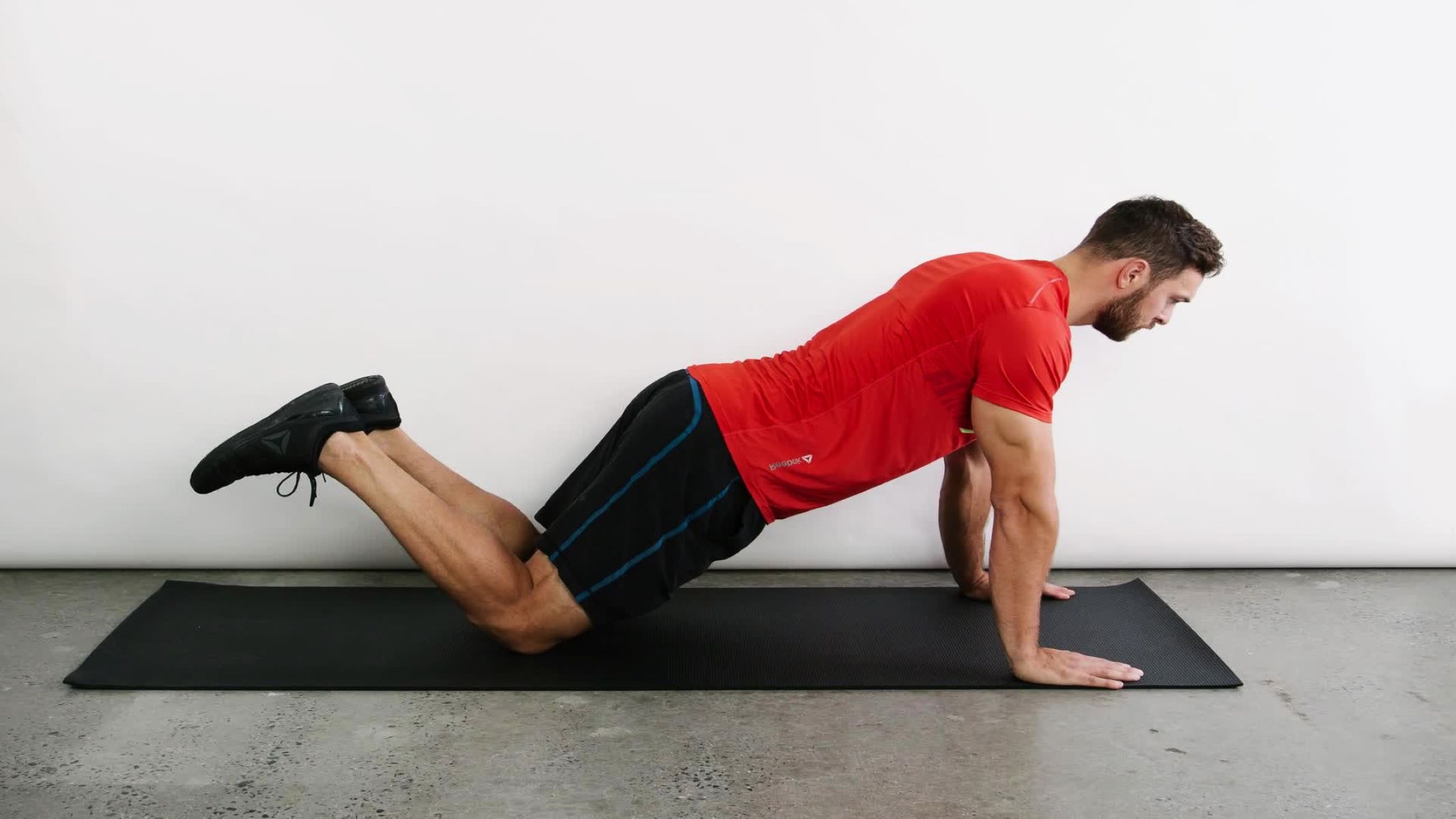Home>Training & Techniques>The Benefits And Techniques Of Incorporating Press-ups Into Your Running Routine


Training & Techniques
The Benefits And Techniques Of Incorporating Press-ups Into Your Running Routine
Published: March 5, 2024
Discover the benefits of adding press-ups to your running routine and learn effective training techniques to enhance your performance. Incorporate these techniques to elevate your training and techniques.
(Many of the links in this article redirect to a specific reviewed product. Your purchase of these products through affiliate links helps to generate commission for Therunningadvisor.com, at no extra cost. Learn more)
Table of Contents
- Introduction
- The Physical Benefits of Press-ups for Runners
- The Mental Benefits of Press-ups for Runners
- Proper Technique for Incorporating Press-ups into Your Running Routine
- Variations of Press-ups to Enhance Your Running Performance
- Precautions and Tips for Adding Press-ups to Your Running Routine
- Conclusion
Introduction
In the quest for improved running performance, athletes often seek out diverse training methods to enhance their strength, endurance, and overall fitness. One such method that has gained popularity among runners is the incorporation of press-ups into their training routine. Press-ups, also known as push-ups, are a fundamental bodyweight exercise that can yield a multitude of physical and mental benefits for runners. By integrating press-ups into their workout regimen, runners can experience enhanced upper body strength, improved core stability, and mental fortitude, all of which are crucial for excelling in the sport.
As runners strive to conquer longer distances, tackle challenging terrains, and achieve personal bests, the significance of a well-rounded training approach cannot be overstated. While running primarily targets the lower body muscles, the inclusion of press-ups serves as a holistic approach to strength training, targeting the upper body, core, and stabilizing muscles. This comprehensive approach not only fosters muscular balance and symmetry but also contributes to injury prevention and overall athletic performance.
Furthermore, the mental benefits of incorporating press-ups into a running routine are equally noteworthy. The discipline and determination required to consistently perform press-ups can translate into mental resilience and fortitude during runs. This mental toughness can be a game-changer, especially during grueling races or challenging training sessions, where the ability to push through discomfort and fatigue can make all the difference.
In the subsequent sections of this article, we will delve deeper into the physical and mental benefits of press-ups for runners, explore the proper techniques for incorporating press-ups into a running routine, discuss variations of press-ups to enhance running performance, and provide precautions and tips for seamlessly integrating press-ups into a running regimen. By the end of this comprehensive guide, runners will have a clear understanding of how press-ups can elevate their training and contribute to their overall success on the track, trail, or road.
The Physical Benefits of Press-ups for Runners
Press-ups offer a myriad of physical advantages that can significantly augment a runner's performance and overall fitness. By incorporating this bodyweight exercise into their training regimen, runners can experience notable improvements in upper body strength, core stability, and muscular endurance. These physical benefits are instrumental in enhancing running efficiency, reducing the risk of injuries, and fostering overall athletic prowess.
Upper Body Strength
The primary physical benefit of press-ups for runners lies in the development of upper body strength. While running predominantly engages the lower body muscles, the upper body is often overlooked. However, a strong upper body is crucial for maintaining proper running form, especially during long-distance runs or challenging terrains. Press-ups effectively target the chest, shoulders, triceps, and upper back, thereby fortifying the muscles essential for arm swing coordination and overall upper body stability while running.
Core Stability
In addition to bolstering upper body strength, press-ups also contribute to the enhancement of core stability. A strong and stable core is pivotal for maintaining proper running posture, optimizing stride efficiency, and minimizing energy wastage. As runners engage in press-ups, the core muscles, including the abdominals, obliques, and lower back, are activated to stabilize the body throughout the exercise. This engagement not only strengthens the core but also translates to improved running mechanics and reduced susceptibility to fatigue-related posture breakdown during long runs.
Muscular Endurance
Furthermore, the repetitive nature of press-ups cultivates muscular endurance, which is indispensable for runners, particularly during prolonged or high-intensity runs. As runners progressively integrate press-ups into their training routine, they can expect an increase in muscular endurance in the upper body and core muscles. This heightened endurance not only supports sustained running performance but also contributes to overall body resilience, enabling runners to tackle challenging terrains and distances with greater ease.
Injury Prevention
Moreover, the development of upper body strength and core stability through press-ups plays a pivotal role in injury prevention for runners. A balanced musculature, encompassing both the lower and upper body, mitigates the risk of overuse injuries and imbalances that may arise from the repetitive nature of running. By fortifying the muscles involved in maintaining proper running form, press-ups serve as a proactive measure to safeguard runners against common injuries, such as shoulder instability, upper back strain, and postural misalignments.
In essence, the physical benefits of incorporating press-ups into a running routine are multifaceted, encompassing the enhancement of upper body strength, core stability, muscular endurance, and injury prevention. By embracing press-ups as a complementary component of their training, runners can cultivate a well-rounded physical foundation that propels them towards peak performance and longevity in their running endeavors.
The Mental Benefits of Press-ups for Runners
In addition to the physical advantages, the incorporation of press-ups into a runner's training routine yields significant mental benefits that can profoundly impact their performance and overall well-being. The mental fortitude cultivated through the consistent practice of press-ups extends beyond the realm of physical fitness, empowering runners to conquer mental barriers, enhance resilience, and fortify their determination.
Discipline and Determination
The act of performing press-ups demands discipline and determination, qualities that are inherently intertwined with successful running endeavors. As runners commit to integrating press-ups into their training regimen, they cultivate a sense of discipline that transcends the exercise itself. The ability to adhere to a structured routine, push through discomfort, and strive for incremental progress mirrors the mental tenacity required to excel in running. This discipline not only fosters consistency in training but also instills a resilient mindset that is invaluable during challenging runs and competitive events.
Mental Resilience
Moreover, the mental resilience honed through the practice of press-ups can be a game-changer for runners. Enduring the physical exertion and discomfort associated with press-ups serves as a mental training ground, where individuals learn to confront and overcome adversity. This resilience translates seamlessly to the realm of running, equipping athletes with the mental strength to persevere through fatigue, discomfort, and moments of doubt. The ability to push through mental barriers and maintain focus during grueling runs can be attributed, in part, to the mental resilience fostered through the consistent practice of press-ups.
Confidence and Self-Efficacy
Furthermore, the mastery of press-ups contributes to an enhanced sense of confidence and self-efficacy among runners. As individuals witness tangible improvements in their ability to perform press-ups, they experience a boost in self-confidence and belief in their capabilities. This newfound confidence extends to their running pursuits, instilling a positive mindset and a belief in their capacity to overcome challenges. The sense of accomplishment derived from conquering press-up milestones translates to a heightened self-assurance that empowers runners to tackle ambitious running goals with unwavering belief in their potential.
Stress Relief and Mental Clarity
Additionally, the practice of press-ups serves as a form of stress relief and mental rejuvenation for runners. Engaging in physical exercise, including press-ups, triggers the release of endorphins, which are known to alleviate stress and elevate mood. This mental rejuvenation not only enhances overall well-being but also fosters mental clarity, enabling runners to approach their training and running endeavors with a focused and composed mindset.
In essence, the mental benefits of incorporating press-ups into a running routine extend far beyond physical fitness, encompassing the cultivation of discipline, determination, resilience, confidence, and mental well-being. By embracing press-ups as a holistic training tool, runners can harness the mental fortitude derived from this exercise to elevate their performance, overcome mental barriers, and embark on their running journeys with unwavering resolve.
Proper Technique for Incorporating Press-ups into Your Running Routine
The proper technique for seamlessly integrating press-ups into a running routine encompasses a strategic approach that optimizes the synergistic benefits of both exercises. By adhering to the following guidelines, runners can effectively incorporate press-ups into their training regimen while maximizing the impact on their overall running performance.
Frequency and Timing
Integrating press-ups into a running routine involves strategic planning to ensure optimal results. It is advisable to perform press-ups on non-running days or as a supplementary component of a cross-training regimen. This approach allows for adequate recovery between running sessions while capitalizing on the strength-building benefits of press-ups. Additionally, incorporating press-ups after a run can serve as a targeted upper body and core strengthening session, complementing the cardiovascular and lower body focus of running.
Gradual Progression
When introducing press-ups into a running routine, gradual progression is key to mitigating the risk of overexertion and injury. Beginners may commence with modified or inclined press-ups to build foundational strength before advancing to traditional floor press-ups. As proficiency and strength improve, runners can gradually increase the number of repetitions and explore variations to continually challenge their muscles. This incremental approach fosters sustainable progress and minimizes the likelihood of overtraining.
Form and Alignment
Maintaining proper form and alignment during press-ups is paramount to maximize their effectiveness and minimize the risk of injury. Runners should position their hands slightly wider than shoulder-width apart, with the body forming a straight line from head to heels. Engaging the core and stabilizing muscles is crucial to uphold proper alignment throughout the exercise. Additionally, focusing on controlled and deliberate movements, including a full range of motion, ensures that the targeted muscles are effectively engaged.
Breathing and Rhythm
Conscious attention to breathing and rhythm during press-ups can optimize their integration into a running routine. Syncing the breathing pattern with the movement, such as inhaling on the descent and exhaling on the ascent, promotes efficient oxygenation and muscle engagement. Establishing a steady rhythm, whether through timed repetitions or sets, fosters a sense of cadence and control, mirroring the rhythmic nature of running. This synchronization contributes to overall coordination and enhances the mind-body connection.
Recovery and Adaptation
Recognizing the importance of recovery and adaptation is integral to the seamless incorporation of press-ups into a running routine. Adequate rest periods between sets and sessions allow for muscle recovery and adaptation, facilitating strength gains and minimizing the risk of overuse injuries. Runners should listen to their bodies, adjusting the frequency and intensity of press-ups as needed to accommodate their running schedule and overall training load.
By adhering to these guidelines, runners can effectively integrate press-ups into their running routine, harnessing the synergistic benefits of strength training and running to elevate their overall athletic performance and resilience.
Variations of Press-ups to Enhance Your Running Performance
Diversifying the repertoire of press-up variations can significantly augment a runner's strength, stability, and overall running performance. By incorporating a range of press-up variations into their training regimen, runners can target specific muscle groups, enhance functional strength, and introduce progressive challenges that translate seamlessly to their running endeavors.
Wide-Arm Press-ups
Wide-arm press-ups, performed with the hands positioned wider than shoulder-width apart, emphasize the engagement of the chest muscles while also recruiting the shoulders and triceps. This variation effectively targets the pectoralis major, contributing to enhanced upper body strength and stability. For runners, the activation of the chest muscles through wide-arm press-ups can bolster arm swing coordination and support the maintenance of proper upper body posture during runs, particularly during fatigue-inducing segments.
Diamond Press-ups
Diamond press-ups, characterized by the formation of a diamond shape with the hands positioned directly beneath the chest, place a heightened emphasis on the triceps and inner chest muscles. This variation offers a targeted approach to strengthening the triceps, which are instrumental for arm drive and propulsion during running. By integrating diamond press-ups into their training routine, runners can fortify the triceps, thereby enhancing their capacity for powerful arm movements and sustained upper body endurance during runs.
Incline and Decline Press-ups
Incorporating incline and decline press-ups introduces variations in elevation, thereby altering the distribution of body weight and the intensity of the exercise. Incline press-ups, performed with the hands elevated on a platform, such as a bench or step, place greater emphasis on the lower chest and shoulders. This variation facilitates a gradual progression for individuals building upper body strength, making it an ideal starting point for beginners. Conversely, decline press-ups, with the feet elevated on a platform, intensify the engagement of the upper chest and shoulders, offering a challenging variation for advanced runners seeking to enhance their upper body strength and stability.
Plyometric Press-ups
Plyometric press-ups, also known as explosive press-ups, incorporate an explosive element into the exercise, involving a rapid push-off from the ground with enough force to achieve airtime. This dynamic variation not only strengthens the chest, shoulders, and triceps but also enhances power and explosiveness in the upper body. For runners, the incorporation of plyometric press-ups can translate to improved arm drive and propulsion, contributing to enhanced sprinting capabilities and overall running speed.
One-Arm and One-Leg Press-ups
One-arm and one-leg press-ups introduce unilateral challenges that demand heightened stability and core engagement. By performing press-ups with one arm or one leg raised, runners can target stabilizing muscles, enhance core strength, and address muscular imbalances. This variation fosters symmetrical development and stability, which is essential for maintaining proper running form and minimizing the risk of asymmetrical gait patterns or imbalances that may lead to injuries.
Incorporating these diverse press-up variations into a running routine not only enhances upper body strength and stability but also introduces progressive challenges that directly contribute to improved running performance. By strategically integrating these variations, runners can cultivate a well-rounded physical foundation that supports their pursuit of endurance, speed, and overall athletic prowess on the track, trail, or road.
Precautions and Tips for Adding Press-ups to Your Running Routine
As runners embark on the journey of incorporating press-ups into their training routine, it is imperative to approach this integration with mindfulness and strategic considerations. While press-ups offer a multitude of benefits, it is essential to exercise caution and adhere to certain precautions to optimize their effectiveness and minimize the risk of potential pitfalls. Additionally, embracing practical tips can streamline the seamless integration of press-ups into a running regimen, ensuring a harmonious balance between strength training and running pursuits.
Gradual Progression and Patience
One of the foremost precautions when adding press-ups to a running routine is the emphasis on gradual progression and patience. Rushing into high-volume or intense press-up sessions can predispose runners to overuse injuries and muscular strain. It is crucial to commence with a manageable number of repetitions and gradually increase the intensity and volume over time. This incremental approach allows the muscles to adapt and strengthen progressively, reducing the likelihood of overexertion and injury.
Proper Form and Alignment
Maintaining proper form and alignment during press-ups is paramount to mitigate the risk of injury and maximize their efficacy. Runners should prioritize a straight body line from head to heels, engage the core muscles, and ensure controlled movements throughout the exercise. Focusing on proper form not only optimizes muscle engagement but also minimizes the strain on joints and connective tissues, fostering a safe and effective press-up practice.
Recovery and Rest Days
Integrating press-ups into a running routine necessitates a mindful approach to recovery and rest days. Overtraining, whether through excessive press-up sessions or inadequate recovery between workouts, can compromise muscular recovery and increase the risk of fatigue-related injuries. Runners should allocate sufficient rest days and prioritize recovery strategies, such as adequate sleep, hydration, and nutrition, to support the adaptation and strengthening of muscles engaged during press-ups.
Cross-Training and Variation
Incorporating cross-training and variation into the overall training regimen is pivotal for runners adding press-ups to their routine. While press-ups contribute to upper body and core strength, a well-rounded training approach encompasses diverse exercises and modalities. Embracing cross-training activities, such as yoga, resistance training, and mobility work, complements the benefits of press-ups, fosters muscular balance, and reduces the likelihood of overuse injuries associated with repetitive movements.
Listen to the Body
Listening to the body's signals and responding accordingly is a fundamental tip for runners integrating press-ups into their training routine. Sensations of discomfort, persistent soreness, or joint pain should not be disregarded. Runners are encouraged to differentiate between the natural muscular fatigue associated with training and indicators of potential overuse or strain. Adjusting the frequency, intensity, or technique of press-ups based on the body's feedback is essential to maintain a sustainable and injury-free training progression.
By embracing these precautions and tips, runners can navigate the integration of press-ups into their running routine with prudence and efficacy. This mindful approach not only optimizes the benefits of press-ups but also fosters a harmonious balance between strength training and running pursuits, empowering runners to elevate their overall athletic performance and resilience.
Conclusion
In conclusion, the incorporation of press-ups into a runner's training routine offers a multifaceted approach to enhancing both physical and mental attributes essential for success in the sport. The physical benefits of press-ups, including the development of upper body strength, core stability, muscular endurance, and injury prevention, contribute to a well-rounded foundation that complements the demands of running. Additionally, the mental benefits derived from the practice of press-ups, such as discipline, determination, resilience, confidence, and stress relief, fortify runners with the mental fortitude necessary to conquer challenges and excel in their endeavors.
By embracing the proper techniques for integrating press-ups into a running routine, including strategic frequency and timing, gradual progression, mindful form and alignment, synchronized breathing and rhythm, and prioritizing recovery and adaptation, runners can optimize the synergistic benefits of strength training and running. Furthermore, the exploration of diverse press-up variations, such as wide-arm press-ups, diamond press-ups, incline and decline press-ups, plyometric press-ups, and one-arm and one-leg press-ups, introduces progressive challenges that directly contribute to improved running performance and overall athletic prowess.
However, it is crucial for runners to approach the addition of press-ups with mindfulness and adherence to precautions, including gradual progression, proper form and alignment, prioritization of recovery and rest days, incorporation of cross-training and variation, and attentive listening to the body's signals. By embracing these precautions and tips, runners can navigate the integration of press-ups into their running routine with prudence and efficacy, fostering a harmonious balance between strength training and running pursuits.
In essence, the integration of press-ups into a runner's training regimen represents a holistic approach to athletic development, encompassing physical strength, mental resilience, and strategic progression. By embracing press-ups as a complementary component of their training, runners can cultivate a well-rounded physical and mental foundation that propels them towards peak performance and longevity in their running endeavors.









